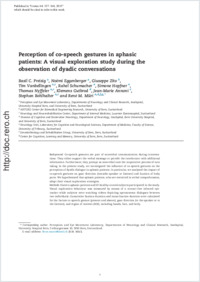Perception of co-speech gestures in aphasic patients: A visual exploration study during the observation of dyadic conversations
- Preisig, Basil C. Perception and Eye Movement Laboratory, Departments of Neurology and Clinical Research, Inselspital, University Hospital Bern, and University of Bern, Switzerland
- Eggenberger, Noëmi Perception and Eye Movement Laboratory, Departments of Neurology and Clinical Research, Inselspital, University Hospital Bern, and University of Bern, Switzerland
- Zito, Giuseppe ARTORG Center for Biomedical Engineering Research, University of Bern, Switzerland
- Vanbellingen, Tim Perception and Eye Movement Laboratory, Departments of Neurology and Clinical Research, Inselspital, University Hospital Bern, and University of Bern, Switzerland - Neurology and Neurorehabilitation Center, Department of Internal Medicine, Luzerner Kantonsspital, Switzerland
- Schumacher, Rahel Perception and Eye Movement Laboratory, Departments of Neurology and Clinical Research, Inselspital, University Hospital Bern, and University of Bern, Switzerland
- Hopfner, Simone Perception and Eye Movement Laboratory, Departments of Neurology and Clinical Research, Inselspital, University Hospital Bern, and University of Bern, Switzerland
- Nyffeler, Thomas Perception and Eye Movement Laboratory, Departments of Neurology and Clinical Research, Inselspital, University Hospital Bern, and University of Bern, Switzerland - Neurology and Neurorehabilitation Center, Department of Internal Medicine, Luzerner Kantonsspital, Switzerland
- Gutbrod, Klemens Division of Cognitive and Restorative Neurology, Department of Neurology, Inselspital, Bern University Hospital, and University of Bern, Switzerland
- Annoni, Jean-Marie Neurology Unit, Laboratory for Cognitive and Neurological Sciences, Department of Medicine, Faculty of Science, University of Fribourg, Switzerland
- Bohlhalter, Stephan Perception and Eye Movement Laboratory, Departments of Neurology and Clinical Research, Inselspital, University Hospital Bern, and University of Bern, Switzerland - Neurology and Neurorehabilitation Center, Department of Internal Medicine, Luzerner Kantonsspital, Switzerland
- Müri, René M. Perception and Eye Movement Laboratory, Departments of Neurology and Clinical Research, Inselspital, University Hospital Bern, and University of Bern, Switzerland - Division of Cognitive and Restorative Neurology, Department of Neurology, Inselspital, Bern University Hospital, and University of Bern, Switzerland - Gerontechnology and Rehabilitation Group, University of Bern, Switzerland - Center for Cognition, Learning and Memory, University of Bern, Switzerland
-
2015
Published in:
- Cortex. - 2015, vol. 64, p. 157–168
English
Co-speech gestures are part of nonverbal communication during conversations. They either support the verbal message or provide the interlocutor with additional information. Furthermore, they prompt as nonverbal cues the cooperative process of turn taking. In the present study, we investigated the influence of co-speech gestures on the perception of dyadic dialogue in aphasic patients. In particular, we analysed the impact of co-speech gestures on gaze direction (towards speaker or listener) and fixation of body parts. We hypothesized that aphasic patients, who are restricted in verbal comprehension, adapt their visual exploration strategies.Methods: Sixteen aphasic patients and 23 healthy control subjects participated in the study. Visual exploration behaviour was measured by means of a contact-free infrared eye-tracker while subjects were watching videos depicting spontaneous dialogues between two individuals. Cumulative fixation duration and mean fixation duration were calculated for the factors co-speech gesture (present and absent), gaze direction (to the speaker or to the listener), and region of interest (ROI), including hands, face, and body.Results: Both aphasic patients and healthy controls mainly fixated the speaker's face. We found a significant co-speech gesture × ROI interaction, indicating that the presence of a co-speech gesture encouraged subjects to look at the speaker. Further, there was a significant gaze direction × ROI × group interaction revealing that aphasic patients showed reduced cumulative fixation duration on the speaker's face compared to healthy controls.Conclusion: Co-speech gestures guide the observer's attention towards the speaker, the source of semantic input. It is discussed whether an underlying semantic processing deficit or a deficit to integrate audio-visual information may cause aphasic patients to explore less the speaker's face.
- Faculty
- Faculté des sciences et de médecine
- Department
- Médecine 3ème année
- Language
-
- English
- Classification
- Medicine
- License
-
License undefined
- Identifiers
-
- RERO DOC 255871
- DOI 10.1016/j.cortex.2014.10.013
- Persistent URL
- https://folia.unifr.ch/unifr/documents/304407
Statistics
Document views: 109
File downloads:
- pdf: 272
